Greg Boland's blog
Back home again …
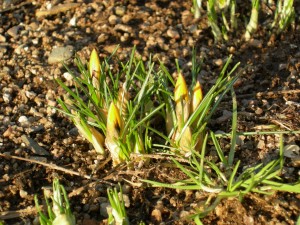 Well, it has been 2-3 weeks since I have been “back home again” – and greeted with spring in Canada. Much of the experience of being in Nepal is still with me. I continue to stay in touch with several of the Nepali people I worked with – as well as some of the international volunteers. And – I am continuing to tie up some loose ends from my work there.
Well, it has been 2-3 weeks since I have been “back home again” – and greeted with spring in Canada. Much of the experience of being in Nepal is still with me. I continue to stay in touch with several of the Nepali people I worked with – as well as some of the international volunteers. And – I am continuing to tie up some loose ends from my work there.
In conclusion – the Leave for Change program seems to be a highly effective program that provides specific expertise in targeted areas of need for short periods of time. All of the organizations involved are focused on the short-term nature of each assignment, and I feel this is critical to accomplishing the stated goals within this short period. All of the organizations were a pleasure to work with.
Who knows – maybe it will be you next time!
Signing off for now …
Greg
Electricity
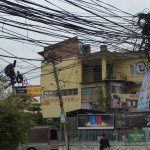

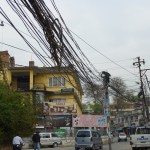 Well – no discussion of life here would be complete without a brief mention of electricity. Life revolves around electricity here – or perhaps the frequent lack of it. For various reasons – there is a shortage of electrical generation in Nepal – with the result that the biggest user of electricity (e.g. Kathmandu) has a “load-shedding”, “power-shedding” or “power cut” schedule that changes daily.
Well – no discussion of life here would be complete without a brief mention of electricity. Life revolves around electricity here – or perhaps the frequent lack of it. For various reasons – there is a shortage of electrical generation in Nepal – with the result that the biggest user of electricity (e.g. Kathmandu) has a “load-shedding”, “power-shedding” or “power cut” schedule that changes daily.
For example, according to my well-worn printed copy of the “Power Cut Schedule” (which is hard to read in the dark…) – today we did not have electricity from 4 to 11 AM, and then again from 4 to 11 PM. The hours of daylight here currently run from 5:45 AM to 6:30 PM. So – if you compare these two schedules – you can see we spend a lot of our evenings in the dark. And – there is a different schedule every day – so tomorrow we will not have power from 2-9 AM and then again from 3-10 PM. To add to the confusion – there are different power-shedding zones in the city – and I work in one zone – and live in another. It takes a while to get used to – and I will let you know when I do.
So – we all spend a lot of time focused on recharging batteries – for laptop computers, cameras, cell phones, portable lights, etc.
Another intersting part of electricity here – is the power lines that run everywhere. I think I can see why there is shortage of copper elsewhere in the world…
“The top of the world”
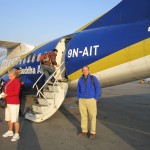

 Yes – “the top of the world” is what we often think about when we think of Nepal – or more specifically – “Mount Everest” – the tallest point of land on our planet. Clearly, the limits on my time and work activity here do not allow for the typical 13 day “Everest Base Camp Trek” that is required to get there (assuming of course that I am even able!). But there is a “Plan B” approach – and that is the early morning “Mountain Flight” from the Kathmandu airport that takes a quick one-hour “fly-by” of the mountain range – pointing out several of the tallest mountains in the world that occur here.
Yes – “the top of the world” is what we often think about when we think of Nepal – or more specifically – “Mount Everest” – the tallest point of land on our planet. Clearly, the limits on my time and work activity here do not allow for the typical 13 day “Everest Base Camp Trek” that is required to get there (assuming of course that I am even able!). But there is a “Plan B” approach – and that is the early morning “Mountain Flight” from the Kathmandu airport that takes a quick one-hour “fly-by” of the mountain range – pointing out several of the tallest mountains in the world that occur here.
So – there we were – up bright and early at 4 AM – to the airport by 5 AM – and after some rather confusing line-ups, ticket sales, tax payments, pat-downs, another pat-down, and then a third pat-down – we were on the “Buddha Air” plane – and eventually rolling down the airstrip into Nepali airspace – by 8.15 AM or so.
A short but wonderful flight; the pictures speak for themselves….
Holi
Celebrating the Holi festival
The Holi festival was on last Saturday – and even though we were warned about the possible consequences – we went anyway – wearing some nonessential clothes…As the CNN website says… “Holi is regarded as one of the greatest festivals, as important as Dashain and Tihar or Dipawali. Since more than 80% of people in Nepal are Hindus, Holi, along with many other Hindu festivals, is celebrated in Nepal as a national festival and almost everyone celebrates it regardless of their religion, e.g., even Muslims celebrate it. Christians may also join in, although since Holi falls during Lent, many would not join in the festivities. The day of Holi is also a national holiday in Nepal.”
“During Holi, people walk down their neighbourhoods to celebrate Holi by exchanging colours and spraying coloured water on one another. A popular activity is the throwing of water balloons at one another, sometimes called lola (meaning water balloon). Also a lot of people mix bhang in their drinks and food, as also done during Shivaratri. It is believed that the combination of different colours played at this festival take all the sorrow away and make life itself more colourful.”
In other words – everyone runs around throwing bags of colored water – or even more popular in the main Thamel district of Kathmandu – is that everyone walks around with handfuls of dry colorful pigments – and come up to you and smear it over your face, etc. Thousands of people are so colored – and this picture is just one group standing around during the middle (muddle?) of the day.
And – for the chronically curious among you – yes – it all washes off easily with a bit of soap and water …
(Remember to click on the photo for the full image)
(http://ireport.cnn.com/docs/DOC-575565?ref=feeds%2Flatest)
Farming is a family business


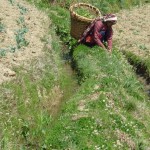 Farming is a family business in Nepal. These pictures show an individual terrace where cauliflower is being grown. These plants were initially grown as seedlings and then transplanted into the soil that was tilled by hand and hoe – and/or plowed by water buffalo. The bags that are scattered through this field contain fertilizer or compost, and each plant is individually treated by hand with both. Watering is also done by hand – and buckets of water are collected from a nearby stream, carried to the terrace, and then ladled onto individual plants as required.
Farming is a family business in Nepal. These pictures show an individual terrace where cauliflower is being grown. These plants were initially grown as seedlings and then transplanted into the soil that was tilled by hand and hoe – and/or plowed by water buffalo. The bags that are scattered through this field contain fertilizer or compost, and each plant is individually treated by hand with both. Watering is also done by hand – and buckets of water are collected from a nearby stream, carried to the terrace, and then ladled onto individual plants as required.
The mother and father are doing most of the field work, whereas the daughter is hand-harvesting various types of forage from the edges of the terraces, and will carry these back to the familiy home in her basket for feeding to the farm animals. Farm animals may include combinations of chickens, goats, water buffalo, cows or pigs. The specific animals present at each farm varies according to the type of farming they do, their family culture, and their religion.
You can see the drainage ditches that run through the terrace – mostly to drain away excess water during the rainy season. This is one of the more progressive farming families in the valley, and the father had completed a 5 month course in integrated pest management of cole crops.
“Hill farming” in Nepal


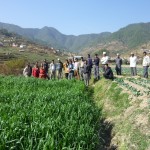

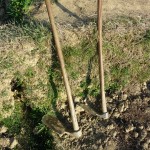
 We spent two days visiting the Bajrabaraha Village District Committee (VDC) in the Makawanpur district of Nepal. This is an area of “hill farming” about 1-1.5 hours outside Kathmandu – “as the crow flies”. However, it took us 4-5 hours to get here “as the jeep drives” – over rough roads, up and down, and in and around the mountains.
We spent two days visiting the Bajrabaraha Village District Committee (VDC) in the Makawanpur district of Nepal. This is an area of “hill farming” about 1-1.5 hours outside Kathmandu – “as the crow flies”. However, it took us 4-5 hours to get here “as the jeep drives” – over rough roads, up and down, and in and around the mountains.
The scenery is magnificant. The “hills” are actually small mountains – ranging up to 2500 m in height. The mountains have quite steep sides – allowing for wonderful views of the scenery as one drives along. However, looking down can be a litle intimidating at times – especailly when your jeep has to pass a speeding bus going the other way – on a single lane dirt road – on a hair-pin turn – while going over a bridge – with everyone honking their horns continuously; which was a fairly regular occurrence…
Much, or even most, of the sides of these hills are farmed. The farmers live in family and small village units along the roads. All of the land is farmed as layered terraces that have been hand-dug over many years – and constantly maintained. There are hundreds of thousands of them – everywhere. The terraces are maintained with a relatively large, heavy “hoe” and the terraces are hand-plowed using water buffalo. All seeds, fertilizers, composts, water, etc., are carried to the terraces – usually in baskets – and usually by women.
We visited at the tail-end of the winter cropping season and many of the terraces were “between crops” or had just been planted with potatoes. The main crops that were still present within the fields included cauliflower, cabbage, raddish and oilseed Brassica (e.g. cole crops). Smaller plots of onions, leafy spices, and wheat were also being grown on some farms.
We spent much of our time in meetings with members of the local cooperative, and then one afternoon walking around parts of the valley – talking with various farmers about disease and pest problems – and what methods they were using to manage them.
Off to work

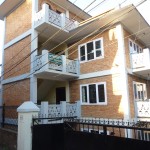
 Of course, the main reason I am here is to go to work – so off to work I go from Sunday to Friday each week (yes, that’s six days per week). To get to work – I need to travel from the northeastern side of the city of Kathmandu to the central region of the adjacent city of Patan. In the morning I use a “tuk tuk” or “tempo” (Photo 1) – where I typically ride along with 8-12 others for 40-45 minutes – and all for the modest price of approx. 25 cents. The tuk tuk is an interesting vehicle – its main merit is that it is 100% electrically powered by a series of 12 car-sized batteries – and therefore makes an enormous contribution to reduced pollution in the city. On the other hand – “part of me” gets the impression that they might also benefit from some shock absorbers!
Of course, the main reason I am here is to go to work – so off to work I go from Sunday to Friday each week (yes, that’s six days per week). To get to work – I need to travel from the northeastern side of the city of Kathmandu to the central region of the adjacent city of Patan. In the morning I use a “tuk tuk” or “tempo” (Photo 1) – where I typically ride along with 8-12 others for 40-45 minutes – and all for the modest price of approx. 25 cents. The tuk tuk is an interesting vehicle – its main merit is that it is 100% electrically powered by a series of 12 car-sized batteries – and therefore makes an enormous contribution to reduced pollution in the city. On the other hand – “part of me” gets the impression that they might also benefit from some shock absorbers!
I work at the National Agriculture Cooperative Central Federation Limited (NACCFL) (Photo 2) which is the umbrella organization of the Small Farmers Agro Cooperative Limited (SFACL). “Small farmers” in this context refers to farmers with very small landholdings (rented or owned) of typically 0.5 acre in size, and with annual income below the poverty threshold. Various definitions of this poverty threshold exist but – in round numbers – this would be less than $0.75 per day income. Humbling indeed.
Most of these cooperatives are located in villages well outside of Kathmandu – and travel to visit them is apparently slow – mostly due to poor roads and high traffic. Many of the villages are in the southern terai (grassland) regions – which are semi-tropical to tropical – and where much of the better agricultural land is located (about 6 hours drive from Kathmandu).
The SFACL is a truly cooperative organization that is fully owned and managed by the local community. Within each village – 3 to 14 families comprise an individual cooperative – and these are then organized into larger regional and district groups – with members from each cooperative responsible for managing the larger groups. In 2010, the collective membership includes more than 200,000 members. The NACCFL and SFACL provide a range of financial and nonfinancial services for its members – ranging from microfinance loans to plant and livestock health programs. For example – two other Canadian volunteers here include Amy – who is training people in statistical software for a microfinance agency – and Claire – who is a veterinarian helping with animal herd health.
For the first few days I have mainly been involved with meeting everyone, discussions and planning on what and how to proceed during my short time here – and a lot of reading on the NACCFL and SFACL, crops and crop problems that occur here, previous projects and initiatives that have already been completed, etc. Nepal clearly has an established and active plant health program already but are very understaffed – and small farmers tend to be underserviced.
Apparently, we will be heading out to the villages later this week for some farm visits and discussions…
At the end of each day – I take a bus home (Photo 3).
Kathmandu site/sight-seeing
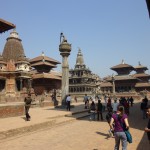



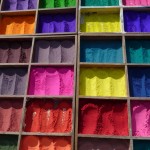
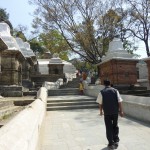
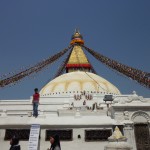
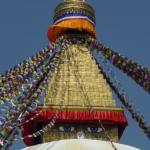
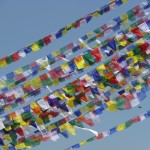
Photos 1-3. As the guidebook says “The Kathmandu Durbar Square holds the palaces of the Malla and Shah kings who ruled over the city. Along with these palaces, the square also surrounds quadrangles revealing courtyards and temples.” Perhaps more simply: “temples, temples, more temples and then even more temples” – all within an area of 2-3 blocks. The initial construction of the place is thought to date back to the 10-11th centuries – but the temples are considered more modern – dating back to the 15-16th centuries. The construction of the various buildings reflects the evolution of various dynasties and rulers – their and favored gods and goddesses over time.
Photos 4-6. The crematorium is a rather sombre but important place within the city – located along the river. A wide variety of goods are for sale by numerous street merchants along the path – including the stands of brightly-colored pigments (e.g. Colors). At the end of this path is a large building that stretches along the river – with 4-10 funeral fires burning under canopies at any one time – with families tending to the fires and the ashes (no pictures – out of respect). Extensive grounds, stairs and related structures are present at this site.
Photos 7-9. The Great Stupa of Boudhanath presents a complete contrast to the crematorium. As one walks down another street and turns the corner – one is immediately accosted by a great white done, with two large eyes, and thousands of colorful prayer flags fluttering in the wind. This one of the holiest Buddhist sites in Kathmandu, one of the largest in the world, and is a UNESCO World Heritage Site. The Stupa is on the ancient trade route from Tibet which enters the Kathmandu valley. Tibetan merchants have rested and offered prayers here for many centuries. The Stupa is said to entomb the remains of Kassapa Buddha, the third of the five Buddhas of the “Fortunate Aeon” (you can google for more info).
Orientation …
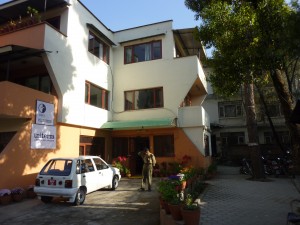
The sounds of barking dogs, crows, motorcycles, temple bells, and braying cattle help wake me each morning. Our agenda for the first two days in Kathmandu was an official orientation from our sponsor agencies at the CECI offices (left side of photo) which are located in the same compound as our accommodations in Passage House (right side of photo). A full day of meetings, including a surprise visit from the regional CIDA representative. Everyone is very organized and helpful. The next day started with a full medical interview and orientation, and then a quick tour of three sites around the city; the Kathmandu Durbar Square, the Kathmandu Crematorium, and the Great Stupa of Boudthanath (pictures will follow soon).
(Note: you can click on images within the blog to get the full image).
The trip …
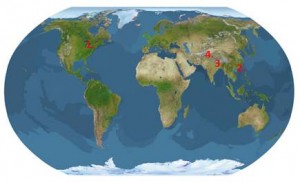
The trip ...
So, how does one get to Nepal? Well – I left Toronto (#1 on map) at 1:30 AM on 5 March on Cathay Pacific – and flew to Hong Kong (#2 on map; 15 hours, approx. 12,500 km) – and then had an 11 hour layover. I met up with Amy – a fellow volunteer coming from Vancouver – in the airport in Hong Kong. Next we took a Cathay Pacific flight from Hong Kong to Dacca, Bangladesh (# 3 on map; 4.5 hours, approx. 2,400 km) and then took the final flight into Kathmandu, Nepal (#4 on map; 1.5 hours, approx. 675 km). So – all totalled – the flights covered approx. 15,575 km and took 37 hours. We were met at the airport by Shashi – our friendly agency driver – and delivered to our accommodation – where I promptly fell into bed and asleep!



